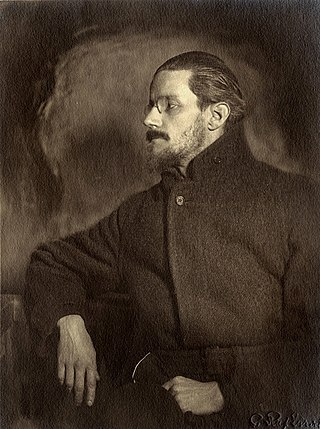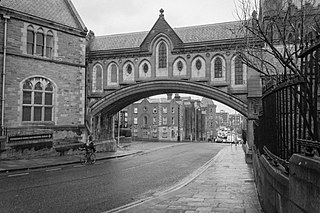
James Augustine Aloysius Joyce was an Irish novelist, poet and literary critic. He contributed to the modernist avant-garde movement and is regarded as one of the most influential and important writers of the 20th century. Joyce's novel Ulysses (1922) is a landmark in which the episodes of Homer's Odyssey are paralleled in a variety of literary styles, particularly stream of consciousness. Other well-known works are the short-story collection Dubliners (1914), and the novels A Portrait of the Artist as a Young Man (1916) and Finnegans Wake (1939). His other writings include three books of poetry, a play, letters, and occasional journalism.

Leopold Bloom is the fictional protagonist and hero of James Joyce's 1922 novel Ulysses. His peregrinations and encounters in Dublin on 16 June 1904 mirror, on a more mundane and intimate scale, those of Ulysses/Odysseus in Homer's epic poem: The Odyssey.

Dubliners is a collection of fifteen short stories by James Joyce, first published in 1914. It presents a naturalistic depiction of Irish middle class life in and around Dublin in the early years of the 20th century.

Delilah is a woman mentioned in the sixteenth chapter of the Book of Judges in the Hebrew Bible. She is loved by Samson, a Nazirite who possesses great strength and serves as the final Judge of Israel. Delilah is bribed by the lords of the Philistines to discover the source of his strength. After three failed attempts at doing so, she finally goads Samson into telling her that his vigor is derived from his hair. As he sleeps, Delilah cuts Samson's hair, thereby enabling her to turn him over to the Philistines.
"The Dead" is the final short story in the 1914 collection Dubliners by James Joyce. It is by far the longest story in the collection and, at 15,952 words, is almost long enough to be described as a novella. The story deals with themes of love and loss, as well as raising questions about the nature of the Irish identity.
"Eveline" is a short story by the Irish writer James Joyce. It was first published in 1904 by the journal Irish Homestead and later featured in his 1914 collection of short stories Dubliners. It tells the story of Eveline, a teenager who plans to leave Dublin for Argentina with her "lover".
Lenehan and Corley appear in at least two works by James Joyce:
"Araby" is a short story by James Joyce published in his 1914 collection Dubliners. The story traces a young boy's infatuation with his friend's sister.
"A Little Cloud" is a short story by James Joyce, first published in his 1914 collection Dubliners. It contrasts the life of the protagonist, Little Chandler, a Dubliner who remained in the city and married, with the life of his old friend Ignatius Gallaher, who had left Ireland to find success and excitement as a journalist and bachelor in London.
"The Sisters" is a short story by James Joyce, the first of a series of short stories called Dubliners. Originally published in the Irish Homestead on 13 August 1904, "The Sisters" was Joyce's first published work of fiction. Joyce later revised the story and had it, along with the rest of the series, published in book form in 1914. The story details a boy's connection with a local priest, in the context of the priest's death and reputation.
"Counterparts" is a short story by James Joyce published in his 1914 collection Dubliners. The story follows a day in the life of an alcoholic scrivener who is unsuccessful in his professional and personal life.
"Clay" is a short story by James Joyce published in his 1914 collection Dubliners. It deals with the reflections of a middle-aged, unmarried woman during the course of her day.
"A Painful Case" is a short story by Irish author James Joyce published in his 1914 collection Dubliners. The story details a platonic affair between an isolated man and a married woman, the breaking off of the affair, and its aftermath.
"Ivy Day in the Committee Room" is a short story by James Joyce published in his 1914 collection Dubliners. Taking place in a political party office after a day of canvassing, the story depicts various campaigners discussing the political candidates and issues of Irish nationalism and Home Rule. "Ivy Day" refers to an Irish holiday that commemorated Charles Stewart Parnell, an important Irish nationalist figure.
"A Mother" is a short story by James Joyce published in his 1914 collection Dubliners. The story centers around a mother who secures a role for her daughter in a series of concerts.
"Grace" is a short story by James Joyce written toward the end of 1905 and published in his 1914 collection Dubliners.
Epiphany in literature refers generally to a visionary moment when a character has a sudden insight or realization that changes their understanding of themselves or their comprehension of the world. The term has a more specialized sense as a literary device distinct to modernist fiction. Author James Joyce first borrowed the religious term "Epiphany" and adopted it into a profane literary context in Stephen Hero (1904–1906), an early version of A Portrait of the Artist as a Young Man. In that manuscript, Stephen Daedalus defines epiphany as "a sudden spiritual manifestation, whether in the vulgarity of speech or of gesture or in a memorable phase of the mind itself." Stephen's epiphanies are moments of heightened poetic perception in the trivial aspects of everyday Dublin life, non-religious and non-mystical in nature. They become the basis of Stephen's theory of aesthetic perception as well as his writing. In similar terms, Joyce experimented with epiphany throughout his career, from the short stories he wrote between 1898 and 1904 which were central to his early work, to his late novel Finnegans Wake (1939). Scholars used Joyce's term to describe a common feature of the modernist novel, with authors as varied as Virginia Woolf, Marcel Proust, Ezra Pound, and Katherine Mansfield all featuring these sudden moments of vision as an aspect of the contemporary mind. Joycean or modernist epiphany has its roots in nineteenth-century lyric poetry, especially the Wordsworthian "spots of time," as well as the sudden spiritual insights that formed the basis of traditional spiritual autobiography. Philosopher Charles Taylor explains the rise of epiphany in modernist art as a reaction against the rise of a “commercial-industrial-capitalist society” during the early twentieth century.

South Great George's Street is a street in south-central Dublin, Ireland.

Winetavern Street is a street in the medieval area of Dublin, Ireland.





